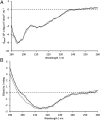Interfacial self-assembly of a bacterial hydrophobin
- PMID: 25870300
- PMCID: PMC4418867
- DOI: 10.1073/pnas.1419016112
Interfacial self-assembly of a bacterial hydrophobin
Abstract
The majority of bacteria in the natural environment live within the confines of a biofilm. The Gram-positive bacterium Bacillus subtilis forms biofilms that exhibit a characteristic wrinkled morphology and a highly hydrophobic surface. A critical component in generating these properties is the protein BslA, which forms a coat across the surface of the sessile community. We recently reported the structure of BslA, and noted the presence of a large surface-exposed hydrophobic patch. Such surface patches are also observed in the class of surface-active proteins known as hydrophobins, and are thought to mediate their interfacial activity. However, although functionally related to the hydrophobins, BslA shares no sequence nor structural similarity, and here we show that the mechanism of action is also distinct. Specifically, our results suggest that the amino acids making up the large, surface-exposed hydrophobic cap in the crystal structure are shielded in aqueous solution by adopting a random coil conformation, enabling the protein to be soluble and monomeric. At an interface, these cap residues refold, inserting the hydrophobic side chains into the air or oil phase and forming a three-stranded β-sheet. This form then self-assembles into a well-ordered 2D rectangular lattice that stabilizes the interface. By replacing a hydrophobic leucine in the center of the cap with a positively charged lysine, we changed the energetics of adsorption and disrupted the formation of the 2D lattice. This limited structural metamorphosis represents a previously unidentified environmentally responsive mechanism for interfacial stabilization by proteins.
Keywords: Bacillus subtilis; BslA; bacterial hydrophobin; biofilm; interfacial self-assembly.
Conflict of interest statement
The authors declare no conflict of interest.
Figures






References
Publication types
MeSH terms
Substances
Grants and funding
- 097945/WT_/Wellcome Trust/United Kingdom
- BB/I019464/1/BB_/Biotechnology and Biological Sciences Research Council/United Kingdom
- BB/L006804/1/BB_/Biotechnology and Biological Sciences Research Council/United Kingdom
- 097945/B/11/Z/WT_/Wellcome Trust/United Kingdom
- BB/L006979/1/BB_/Biotechnology and Biological Sciences Research Council/United Kingdom
LinkOut - more resources
Full Text Sources
Other Literature Sources
Molecular Biology Databases
Miscellaneous

